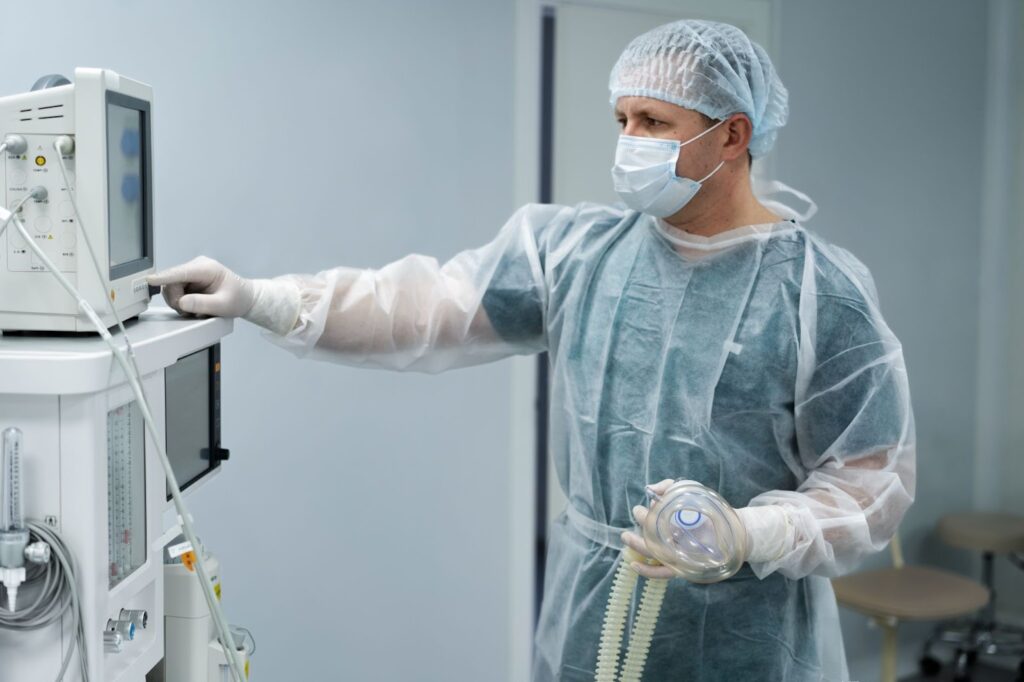Exploring the Uses and Dangers of Halothane Gas
Halothane, often referred to colloquially as “halothane gas,” stands as a cornerstone in the annals of medical progress, marking its place as among the earliest artificially produced inhalation anesthetics. Its debut and widespread acceptance heralded a paradigm shift in surgical practices, presenting a dependable and effective means of inducing anesthesia throughout various surgical procedures. Delving into its historical import, distinctive attributes, practical applications in clinical settings, and the gradual decline in its utilization within the medical realm, we uncover a narrative rich with evolution and innovation.
Discovery and Development of Halothane:
In the annals of medical history, the year 1951 marked a significant milestone with the synthesis of Halothane, a groundbreaking achievement credited to Charles Suckling, an esteemed British chemist laboring under the banner of Imperial Chemical Industries (ICI). Suckling’s endeavor wasn’t merely a stroke of luck; rather, it stemmed from a profound quest to revolutionize anesthesia. The prevailing anesthetic agents of the time, ether and cyclopropane, posed grave risks due to their flammability and explosiveness. Suckling and his team embarked on a mission to discover safer alternatives, birthing Halothane.
The Journey to Uncover Halothane:
- Scientific Endeavor: Suckling’s research wasn’t solitary; it was a concerted effort backed by rigorous scientific inquiry and experimentation;
- Safety Concerns: The urgency to find alternatives to flammable anesthetics like ether and cyclopropane underscored the paramount importance of safety in medical procedures;
- Promising Discovery: Halothane’s emergence as a non-flammable and minimally soluble substance in blood offered a ray of hope, promising a new era in anesthesia.
Properties and Mechanism of Action: Unveiling the Science Behind Halothane:
Diving into the chemical intricacies of Halothane reveals its classification within the esteemed halogenated hydrocarbon family of anesthetics. At its core lies a molecular structure adorned with fluorine atoms, distinguishing it as a halogenated alkane. However, Halothane’s significance transcends its chemical makeup; it’s the manner in which it interacts with the human brain that unveils its true potency.
Exploring Halothane’s Properties:
- Non-Flammability: Unlike its predecessors, Halothane boasts a remarkable resistance to ignition, ensuring safer surgical environments;
- Low Blood Solubility: Halothane’s minimal solubility in blood not only facilitates precise dosage control but also contributes to faster induction and emergence from anesthesia, enhancing patient recovery.
Unlocking Halothane’s Mechanism of Action:
Halothane’s journey from the anesthetic arsenal to the brain’s receptors is a tale of molecular interaction and neurological modulation. Its affinity for gamma-aminobutyric acid (GABA) receptors orchestrates a symphony of inhibitory neurotransmission, casting a veil of sedation and anesthesia over the conscious mind.
Delving Deeper into Mechanism:
- GABA Receptor Interaction: Halothane’s binding to GABA receptors unleashes a cascade of events, potentiating inhibitory signals within the brain;
- Neurotransmission Modulation: By augmenting inhibitory neurotransmission, Halothane stifles neuronal activity, inducing a state of sedation conducive to surgical interventions.
Medical Applications:
Halothane, an inhalational anesthetic introduced in the mid-20th century, transformed the landscape of anesthesia with its unique properties and versatile applications. Its swift onset, precise control over anesthesia depth, and comparatively low toxicity heralded a new era in surgical procedures. Embraced by anesthesiologists worldwide, halothane emerged as the go-to anesthetic for various surgeries, spanning from routine procedures to intricate interventions.
Expanded Information:
- Versatility in Anesthesia: Halothane’s versatility extended beyond traditional anesthesia, finding utility in diverse medical scenarios such as induction and maintenance of anesthesia in both adult and pediatric patients. Its adaptability across age groups and surgical specialties rendered it indispensable in the medical field;
- Safety Profile: Despite its widespread adoption, understanding halothane’s safety profile was crucial. Anesthesiologists valued its stability across a broad spectrum of conditions, facilitating prolonged surgeries without compromising patient safety. The predictability of its effects and ease of administration contributed to its widespread use;
- Pleasant Induction: A notable feature of halothane was its pleasant odor and smooth induction, enhancing the patient experience and easing the apprehensions of medical personnel. This characteristic made it particularly suitable for pediatric patients, where compliance with anesthesia induction is essential for successful outcomes.
Advantages and Considerations:
Halothane’s introduction marked a significant advancement in anesthesia practices, offering unparalleled advantages while necessitating careful considerations.
Advantages:
- Stability: Halothane’s stability under varying conditions provided anesthesiologists with a reliable tool for prolonged surgical interventions. Its consistent performance ensured smooth anesthesia delivery throughout extended procedures, minimizing interruptions and enhancing surgical precision;
- Patient Comfort: The pleasant aroma of halothane and its gentle induction process fostered a comfortable environment for patients undergoing anesthesia. This contributed to reduced anxiety levels and improved overall patient satisfaction, reinforcing its status as a preferred anesthetic choice;
- Ease of Use: Anesthesiologists appreciated halothane for its ease of administration and predictable effects. Its straightforward dosing regimen and rapid onset streamlined anesthesia protocols, optimizing workflow efficiency in operating rooms.
Considerations:
- Hepatotoxicity Risk: Despite its benefits, halothane posed a risk of hepatotoxicity, particularly in susceptible individuals. Anesthesiologists exercised caution when administering halothane to patients with pre-existing liver conditions, employing alternative anesthetic agents when necessary to mitigate potential risks;
- Malignant Hyperthermia: Another concern associated with halothane use was the rare but severe complication of malignant hyperthermia. This life-threatening condition manifested as a hypermetabolic reaction to certain anesthetics, necessitating prompt recognition and intervention to prevent adverse outcomes.
Decline in Usage of Halothane:
Once a cornerstone in the realm of anesthesia, the reign of halothane started to wane as the 20th century drew to a close. While it had enjoyed widespread acceptance for many years, newer inhalation anesthetics gradually stole the spotlight. Here’s why:
- Emergence of Safer Alternatives: The rise of anesthetics like sevoflurane and desflurane offered an enticing proposition for medical practitioners. These alternatives boasted superior safety profiles, mitigating concerns about adverse effects associated with halothane usage;
- Enhanced Pharmacokinetics: Sevoflurane and desflurane brought to the table rapid onset and offset of action. This meant quicker induction and emergence from anesthesia, improving patient recovery times and reducing the risk of prolonged sedation;
- Reduced Metabolic Burden: Unlike halothane, which underwent significant hepatic metabolism, newer agents such as sevoflurane and desflurane were metabolically inert. This not only simplified their elimination from the body but also decreased the likelihood of hepatotoxicity, a notable concern with halothane;
- Intravenous Alternatives: Advancements in intravenous anesthesia formulations offered an additional avenue for anesthetic management. Drugs like propofol and etomidate gained traction for their precise control over sedation levels and rapid onset of action, further chipping away at halothane’s dominance;
- Technological Innovations: Alongside the evolution of anesthetic agents, progress in anesthesia delivery methods played a pivotal role in relegating halothane to the sidelines. From sophisticated vaporizers to precise dosing systems, these innovations provided clinicians with more precise control over anesthesia administration, reducing the reliance on halothane’s broader spectrum of action.
Safety and Potential Side Effects of Halothane Anesthesia
Halothane, a commonly used anesthetic, has been hailed for its effectiveness in inducing anesthesia. However, it’s crucial to acknowledge the potential risks associated with its use. Understanding these risks can help healthcare providers and patients make informed decisions regarding anesthesia options. Here’s an in-depth look at the safety considerations and side effects linked to halothane:

Hepatotoxicity Concerns:
- One of the foremost concerns with halothane administration is its potential to cause hepatotoxicity, particularly in individuals with pre-existing liver conditions or those who undergo multiple exposures or prolonged anesthesia sessions;
- Patients undergoing halothane anesthesia are subjected to careful monitoring of liver function to detect any signs of hepatocellular damage promptly;
- Rare but severe adverse reactions such as hepatocellular necrosis and hepatitis have been reported in association with halothane use, emphasizing the need for vigilance and proactive management strategies.
Malignant Hyperthermia (MH) Risk:
- Another critical complication linked to halothane anesthesia is malignant hyperthermia (MH), a rare yet potentially life-threatening condition characterized by an exaggerated metabolic response to certain anesthetics, including halothane;
- MH can manifest as rapid increases in body temperature, muscle rigidity, metabolic acidosis, and cardiac arrhythmias, necessitating swift recognition and intervention;
- Healthcare professionals are trained to assess patients for susceptibility to MH before administering halothane anesthesia. Furthermore, established protocols for managing MH reactions are in place to ensure prompt and effective treatment.
Exploring Safer Alternatives in Anesthesia:
In light of safety concerns surrounding halothane, the medical community has embarked on a dedicated journey to uncover alternative anesthetic agents that boast improved safety profiles. This concerted effort stems from a commitment to enhancing patient care and reducing the risks associated with anesthesia administration. Modern anesthesia practice now embraces a diverse array of agents that not only rival the efficacy of halothane but also mitigate the potential for adverse reactions. Here’s a closer look at the exploration of safer alternatives in anesthesia:
- Sevoflurane: This volatile inhalational anesthetic has gained popularity due to its rapid onset and offset of action, making it particularly suitable for outpatient procedures. Its low airway irritation and minimal metabolism offer a favorable safety profile, positioning it as a preferred alternative to halothane in many clinical scenarios;
- Desflurane: Known for its rapid emergence from anesthesia and low solubility, desflurane is favored for its ability to facilitate swift recovery and extubation. Its reduced propensity for causing cardiac depression makes it a compelling choice for patients with cardiovascular concerns, further solidifying its role as a safer alternative in anesthesia practice;
- Propofol: Widely recognized for its rapid onset and short duration of action, propofol has become a cornerstone of modern anesthesia induction. Its favorable hemodynamic profile and minimal postoperative nausea and vomiting make it an attractive option for patients across various surgical specialties, providing yet another avenue for safe and effective anesthesia delivery.
Patient Education and Empowerment in Anesthesia Decision-Making:
Informed consent serves as the cornerstone of patient-centered anesthesia care, particularly concerning the potential risks associated with halothane and other anesthetic agents. Healthcare providers are tasked with engaging patients in comprehensive discussions that illuminate the landscape of anesthesia options, empowering individuals to make informed decisions regarding their care. Here’s how patient education and empowerment play pivotal roles in anesthesia decision-making:
- Transparent Communication: Healthcare providers should foster an environment of transparency, openly discussing the benefits and risks associated with various anesthesia options. By providing clear and accessible information, patients can gain a deeper understanding of their treatment options, enabling them to participate actively in the decision-making process;
- Shared Decision-Making: Encouraging patients to voice their questions and concerns fosters a collaborative partnership between healthcare providers and individuals undergoing anesthesia. This shared decision-making approach not only enhances patient satisfaction but also promotes a sense of autonomy and empowerment, ultimately leading to more favorable treatment outcomes;
- Risk-Benefit Assessment: Through thoughtful dialogue, patients and healthcare providers can conduct a comprehensive risk-benefit assessment tailored to the individual’s medical history and preferences. This personalized approach ensures that anesthesia decisions align with the patient’s unique needs and circumstances, optimizing safety and efficacy throughout the perioperative period.
Conclusion
Halothane gas has been instrumental in revolutionizing contemporary anesthesia, profoundly impacting surgical procedures and the management of patient comfort. The unveiling and enhancement of this gas represent a significant chapter in the annals of medical achievements, offering healthcare professionals a more reliable and efficient method for administering anesthesia. Although its application has diminished over time, halothane continues to stand as a testament to ingenuity and advancement within the realm of anesthesiology, engraving a permanent imprint on medical history.

